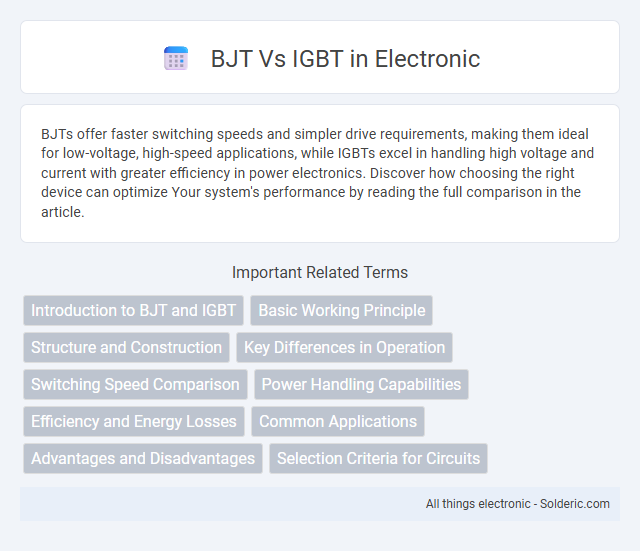BJTs offer faster switching speeds and simpler drive requirements, making them ideal for low-voltage, high-speed applications, while IGBTs excel in handling high voltage and current with greater efficiency in power electronics. Discover how choosing the right device can optimize Your system's performance by reading the full comparison in the article.
Comparison Table
| Feature | BJT (Bipolar Junction Transistor) | IGBT (Insulated Gate Bipolar Transistor) |
|---|---|---|
| Type | Current-controlled device | Voltage-controlled device |
| Switching Speed | High switching speed | Moderate switching speed |
| Conduction Loss | Higher conduction losses | Lower conduction losses |
| Voltage Rating | Up to ~100V | Up to several kV (commonly 600V-3300V) |
| Current Rating | Lower current capacity | High current capacity |
| Control Complexity | Requires base current drive | Gate voltage drive, easier to control |
| Thermal Stability | Prone to thermal runaway | Better thermal stability |
| Applications | Amplifiers, low voltage switching | Motor drives, inverters, high power switching |
Introduction to BJT and IGBT
Bipolar Junction Transistors (BJTs) are semiconductor devices that amplify current, using both electron and hole charge carriers, and are widely utilized in analog circuits. Insulated Gate Bipolar Transistors (IGBTs) combine the high-input impedance of MOSFETs with the high current and voltage capabilities of BJTs, making them ideal for power switching applications. BJTs operate via current control, whereas IGBTs are voltage-controlled devices offering high efficiency in high-voltage environments.
Basic Working Principle
BJT (Bipolar Junction Transistor) operates by using both electron and hole charge carriers, where a small base current controls a larger collector current through transistor junctions. IGBT (Insulated Gate Bipolar Transistor) combines the high input impedance of a MOSFET gate with the bipolar conduction of a BJT, controlled by voltage applied to the insulated gate terminal. The fundamental difference lies in BJT's current-driven operation versus IGBT's voltage-driven mechanism, impacting switching speed and efficiency in power electronics applications.
Structure and Construction
BJT (Bipolar Junction Transistor) features a three-layer semiconductor structure with alternating P-type and N-type materials forming two PN junctions, which enables current control through minority carriers. IGBT (Insulated Gate Bipolar Transistor) combines a MOSFET's insulated gate structure with a BJT-like bipolar conduction region, providing high input impedance and efficient power handling. Understanding the distinct layered construction helps you select the appropriate transistor type for switching speed and power applications.
Key Differences in Operation
BJT (Bipolar Junction Transistor) operates through both electron and hole charge carriers, enabling current flow by injecting minority carriers across a junction, while IGBT (Insulated Gate Bipolar Transistor) combines the high input impedance of a MOSFET with the bipolar conduction of a BJT for efficient switching. BJTs are current-controlled devices with faster switching but higher conduction losses, whereas IGBTs are voltage-controlled and designed to handle higher voltages and currents with lower conduction losses. Your choice between BJT and IGBT depends on the application's switching speed and power efficiency requirements.
Switching Speed Comparison
BJT (Bipolar Junction Transistor) exhibits faster switching speeds compared to IGBT (Insulated Gate Bipolar Transistor) due to its minority carrier operation and simpler structure, making it ideal for high-frequency applications. IGBTs tend to have slower switching times because of the charge storage effect in their drift region, which increases turn-off delay and switching losses. Choosing between BJT and IGBT depends on your specific application, especially when switching speed is a critical factor.
Power Handling Capabilities
IGBTs excel in power handling capabilities, efficiently managing voltages up to 1200V and currents exceeding 100A, making them ideal for high-power applications such as industrial motor drives and renewable energy systems. BJTs, while offering good current gain and high-speed switching, typically operate at lower voltage and current ratings, limiting their use in ultra-high power environments. The superior thermal performance and lower conduction losses of IGBTs contribute to their dominance in power electronics where robust power handling is critical.
Efficiency and Energy Losses
BJTs generally exhibit higher switching losses compared to IGBTs, making IGBTs more efficient for high-voltage, high-current applications due to their lower on-state voltage drop and reduced conduction losses. Your choice of semiconductor affects overall energy efficiency, with IGBTs preferred in power electronics where minimizing heat dissipation and improving thermal management are critical. BJTs, while offering faster switching speeds, typically generate more energy losses during operation, impacting efficiency in large-scale power systems.
Common Applications
BJTs are commonly used in low-power amplification and switching applications such as audio amplifiers and small signal processing due to their fast switching speed and linearity. IGBTs dominate high-power applications like motor drives, induction heating, and power inverters thanks to their high efficiency and ability to handle large voltages and currents. Your choice between BJT and IGBT will depend on the power requirements and switching frequency of your specific application.
Advantages and Disadvantages
BJT (Bipolar Junction Transistor) offers high current density and better conduction efficiency at low voltages, making it suitable for applications requiring fast switching and high gain; however, it suffers from higher power dissipation and lower switching speeds compared to IGBT. IGBT (Insulated Gate Bipolar Transistor) combines the high input impedance of MOSFETs with the high current handling capability of BJTs, providing superior efficiency in high-voltage, high-power applications, but it tends to have slower switching times and higher conduction losses at low voltages. Choosing between BJT and IGBT depends on factors such as switching frequency, voltage, current levels, and thermal performance requirements.
Selection Criteria for Circuits
Choosing between BJT and IGBT for your circuits depends on voltage and current requirements, switching speed, and efficiency. BJTs excel in low-voltage, high-speed applications due to their fast switching and linear amplification capabilities, while IGBTs are preferred for high-voltage, high-current power electronics because of their lower conduction losses and better thermal performance. Consider the specific power rating, switching frequency, and thermal management constraints to optimize your circuit design for reliability and performance.
BJT vs IGBT Infographic

 solderic.com
solderic.com